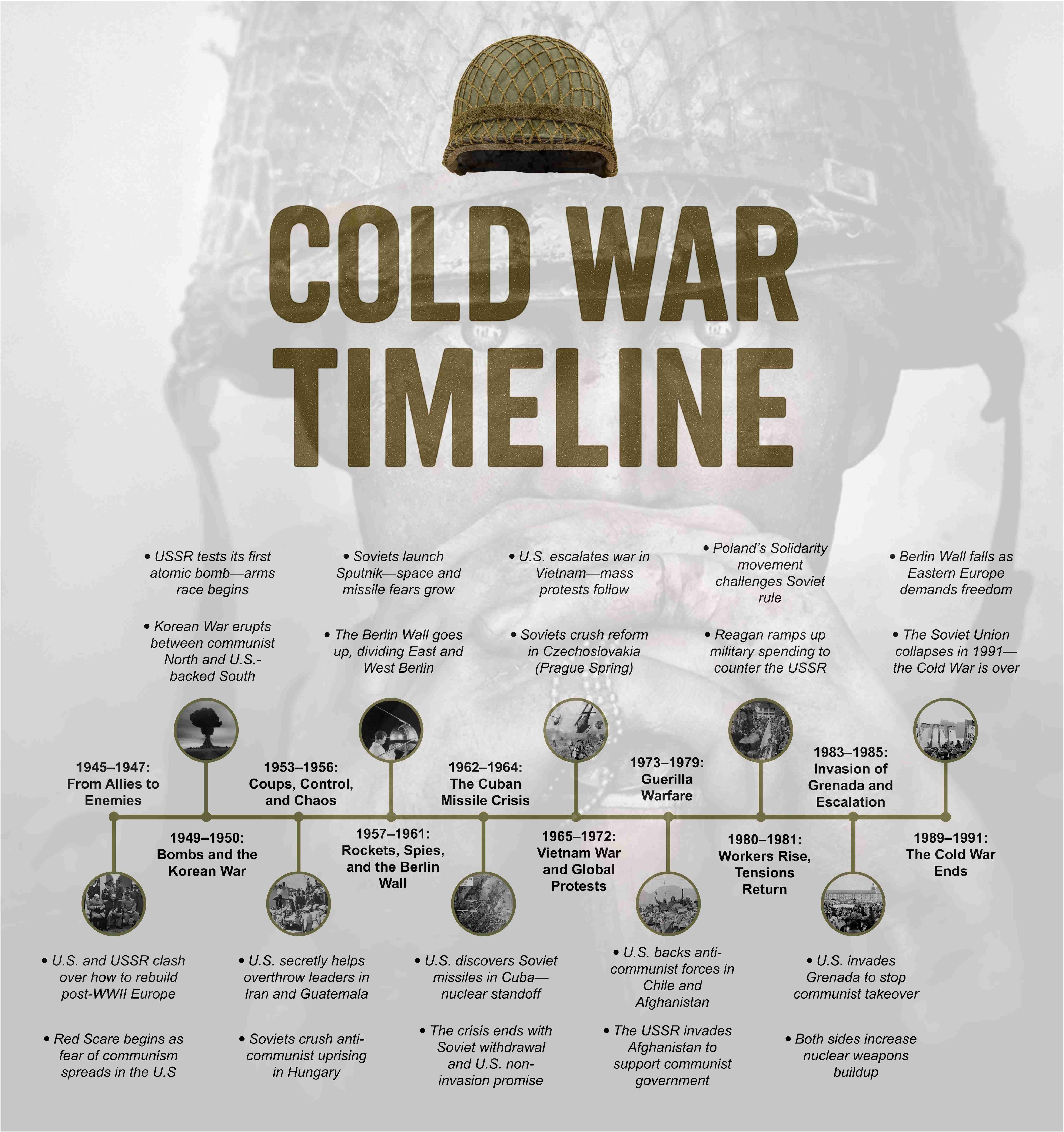The year is 1945. The world’s just survived the deadliest war in history, and you’d think everyone would be ready to chill. But nope. Instead of peace, the stage is set for a brand-new showdown: the Cold War.
The Cold War wasn’t fought with tanks storming across borders every day. It was a battle of influence, power, and fear. From the end of World War II, the U.S. and USSR began shaping global history. They clashed through espionage, nuclear threats, and fierce competition. The U.S. pushed democracy and capitalism, while the Soviets demanded communism and control.
In this timeline, you’ll see secret missions, close calls, and rival superpowers. It's history, but with way more drama than you'd expect.
The Cold War Timeline
The Cold War lasted from the late 1940s until the early 1990s. It was marked by tension, secrecy, and high-stakes rivalries. From Berlin’s walls to the Cuban crisis, each confrontation pushed the world closer to disaster.
The term “Cold War” (credited to George Orwell) meant the U.S. and USSR never openly fought each other. Their battle was hidden in espionage, propaganda, and global influence. Both sides raced to spread their beliefs, build weapons, and control the balance of power.
This comprehensive cold war timeline highlights the major moments that shaped the Cold War from 1945 to the 1990s.
1945 - 1947: From Allies to Enemies
World War II finally ended, and hopes for peace were high. Yet the U.S. and the Soviet Union quickly fell apart as partners. Their visions for the world were too different. Washington wanted free elections and open markets, while Moscow demanded communist control across Eastern Europe.
In America, suspicion spread fast. The Red Scare began, with people fearing communist spies in Hollywood, schools, and even government offices. Once wartime allies, the two nations were now bitter rivals. The Cold War had officially begun.
1949 - 1950: Bombs and the Korean War
The Soviets shocked the world in 1949 when they tested their first atomic bomb. Until then, the U.S. had the nuclear advantage. Suddenly, both sides were racing to build stronger, deadlier weapons. The fear of nuclear war grew across the globe.
A year later, the Cold War turned violent. North Korea, backed by Moscow and Beijing, invaded South Korea. The U.S. stepped in to defend its ally. The war lasted three years, left millions dead, and ended without victory. Korea remained divided, and the Cold War grew more dangerous.
1953 - 1956: Coups, Control, and Chaos
The 1950s saw the Cold War fought in secret as much as in open battles. The CIA helped topple governments in Iran and Guatemala, replacing leaders who leaned toward communism with ones friendly to U.S. interests. These hidden moves fueled mistrust around the world.
Meanwhile, Eastern Europe tested Soviet control. In 1956, Hungarians rose up, demanding freedom from Moscow’s rule. Their courage was met with Soviet tanks and troops. Thousands were killed, and the uprising was crushed. The message was clear: the Soviet Union would not let go of its empire.
1957 - 1961: Rockets, Spies, and the Berlin Wall
The launch of Sputnik in 1957 sent shockwaves through the U.S. The Soviet satellite proved Moscow could reach space, and maybe target America with missiles. The Space Race began, and technology became as important as armies. Espionage also grew, with spies on both sides chasing secrets.
In 1959, Fidel Castro rose to power in Cuba, drawing close to the Soviets. Only two years later, East Germany built the Berlin Wall. Overnight, families and friends were split apart. The Wall became the ultimate symbol of division between East and West.
1962 - 1964: The Cuban Missile Crisis
Tension reached its peak in 1962. U.S. planes discovered Soviet missiles in Cuba, just minutes away from striking American cities. President Kennedy ordered a blockade, and for nearly two weeks the world feared nuclear war could start at any moment.
A deal was finally reached. The Soviets agreed to remove their missiles, while the U.S. promised not to invade Cuba. Disaster was narrowly avoided, but the scare left a permanent mark. Both sides had come terrifyingly close to nuclear conflict.
1965 - 1972: Vietnam War and Global Protests
The Vietnam War became the centerpiece of the Cold War conflict in the late 1960s. The U.S. poured in troops, hoping to stop communism. The fighting was long and brutal, and the images on television shocked Americans at home. Protests grew larger every year, demanding an end to the war.
In Europe, the Prague Spring of 1968 gave people hope for reform in Czechoslovakia. Soviet tanks crushed that hope. Meanwhile, Washington and Moscow began small talks about limiting nuclear weapons. Even in chaos, the first signs of diplomacy appeared.
1973 - 1979: Guerilla Warfare
Even after Vietnam, the superpowers found new battlegrounds. In Chile, the U.S. helped remove a socialist president. In Afghanistan, Soviet forces supported a communist government, while the U.S. secretly armed rebels known as the Mujahideen. Smaller nations became unwilling arenas for Cold War rivalry.
When Soviet troops invaded Afghanistan in 1979, the conflict dragged on. The resistance was fierce, and U.S. aid kept the rebels fighting. For Moscow, Afghanistan turned into a draining, unpopular war. Many called it the Soviet Union’s “Vietnam.” The costs weakened their grip on global power.
1980 - 1981: Workers Rise, Tensions Return
In Poland, shipyard workers started the Solidarity movement. They demanded better rights and greater freedom. For the Soviet Union, this was a dangerous example. Yet Solidarity grew and inspired hope across Eastern Europe. People began to dream of breaking free from communist control.
Meanwhile, U.S. President Ronald Reagan took a harder stance against Moscow. He boosted military spending and warned of the “evil empire.” The arms race accelerated once again. Peace felt far away, and the Cold War entered a sharp new phase of rivalry.
1983 - 1985: Invasion of Grenada and Escalation
Grenada became the next flashpoint in 1983. The U.S. invaded after a communist government took power on the island. American forces quickly removed it, but the Soviets condemned the move as aggressive interference. Tension deepened between the two sides.
Nuclear weapons stockpiles kept rising. Both superpowers were determined to stay ahead. Ordinary people feared the possibility of war more than ever. Still, quiet negotiations began in the background. Arms control was becoming a serious topic. The Cold War was at its peak but also starting to shift.
1989 - 1991: The Cold War Ends
Eastern Europe erupted with protests in 1989. People demanded freedom, and one by one communist governments collapsed. In Germany, the Berlin Wall finally came down. Families were reunited, and the world celebrated. The symbol of division was gone.
Only two years later, the Soviet Union itself dissolved. Fifteen new nations were born, including Russia. The Cold War had ended after nearly half a century of rivalry. Instead of war, it closed with people choosing independence and freedom. The global order was forever changed.
How to Make the Cold War Timeline in EdrawMax?
The Cold War was a tense period of political, military, and ideological rivalry between the United States and the Soviet Union. A timeline is an excellent way to organize and present the key events, crises, and turning points of this era in a clear and structured way.
If you’re new to creating diagrams, EdrawMax makes it simple to design professional-looking timelines quickly. Here’s how to create your Cold War Timeline using EdrawMax:
Step1Open a Blank Workspace
- Open EdrawMax on your computer, and sign in (or create a new account if you don’t already have one).
- Click New on the left panel.
- Choose Blank Drawing to start with a fresh canvas for your Cold War timeline.
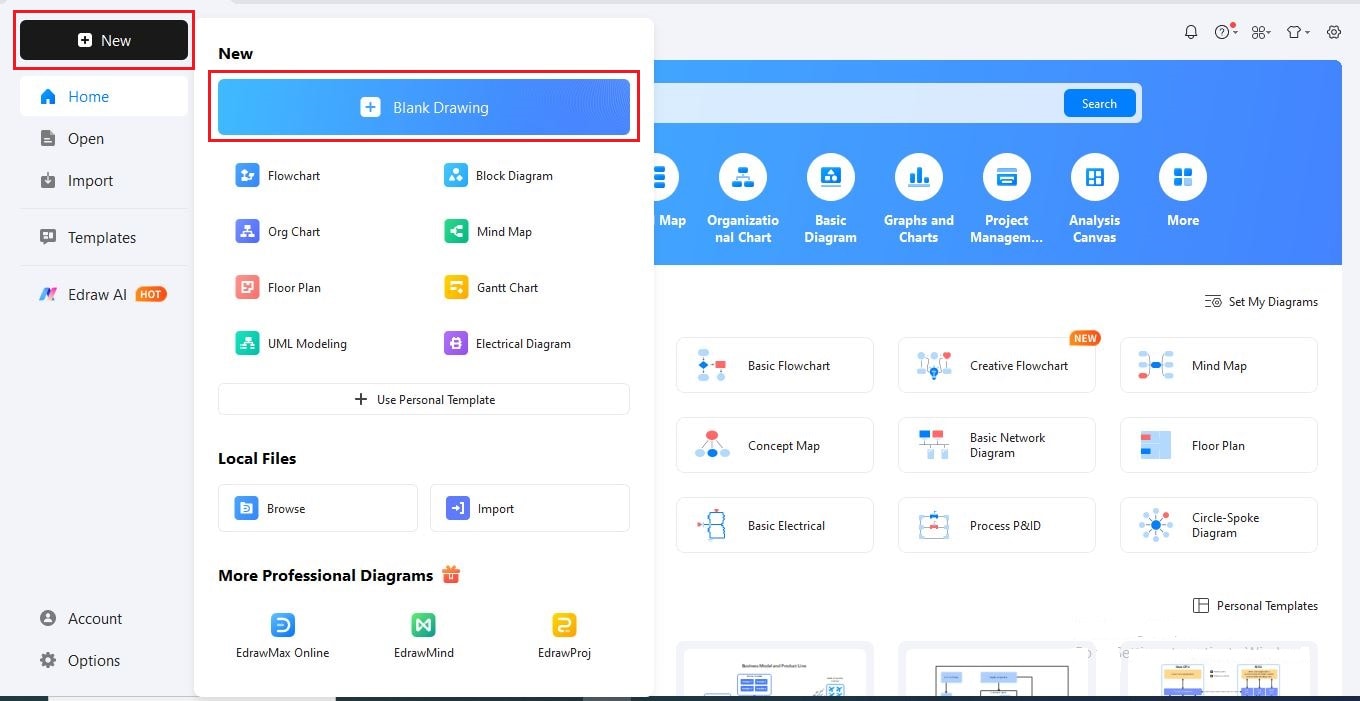
Step2Add a Background Image
- Set a background that reflects the Cold War era.
- Go to the Insert tab in the top toolbar.
- Select Picture > Local Pictures and upload an image.
- On the floating toolbar, click Adjust to customize transparency, and lock it with Move to Layer so it stays in place.
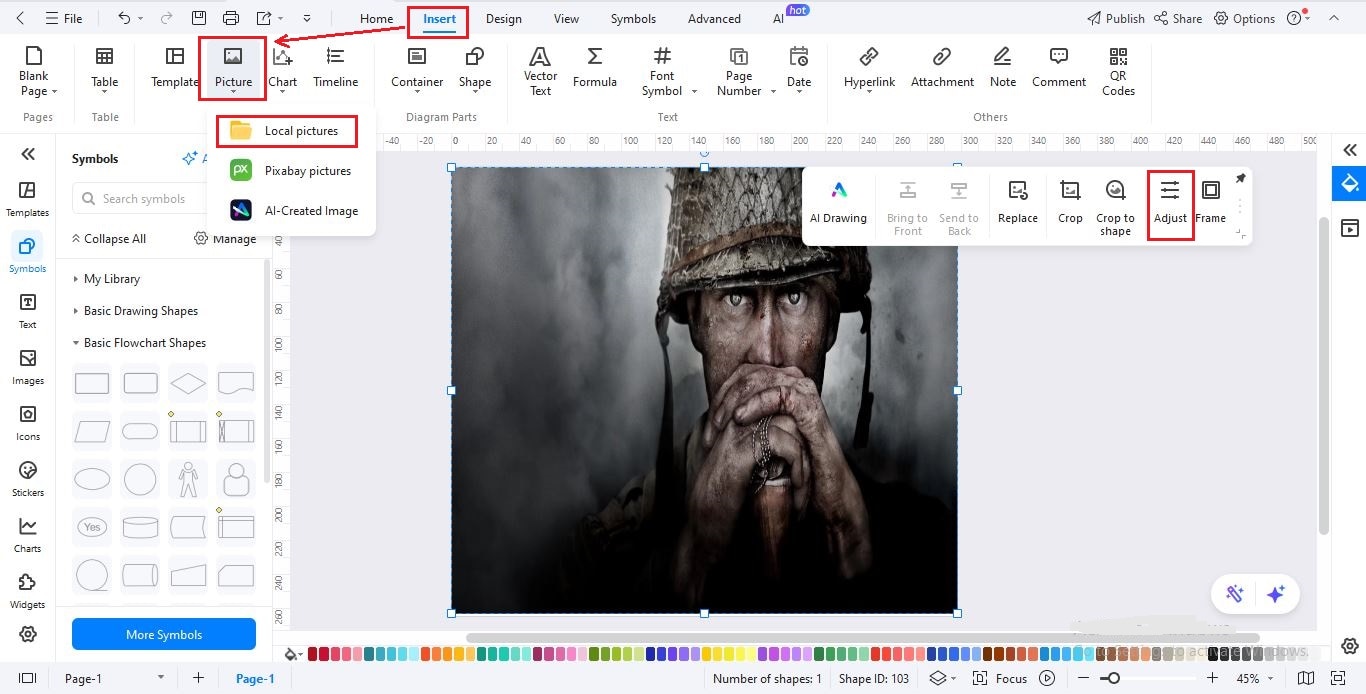
Step3Add a Title for the Timeline
- Give your timeline a bold heading, such as the Cold War Timeline.
- You can use a text box or upload a styled graphic. Follow: Insert > Picture > Local Pictures.
- Optionally, add Cold War symbols like the hammer and sickle, combat ihelmet, or NATO emblem for extra visual context.
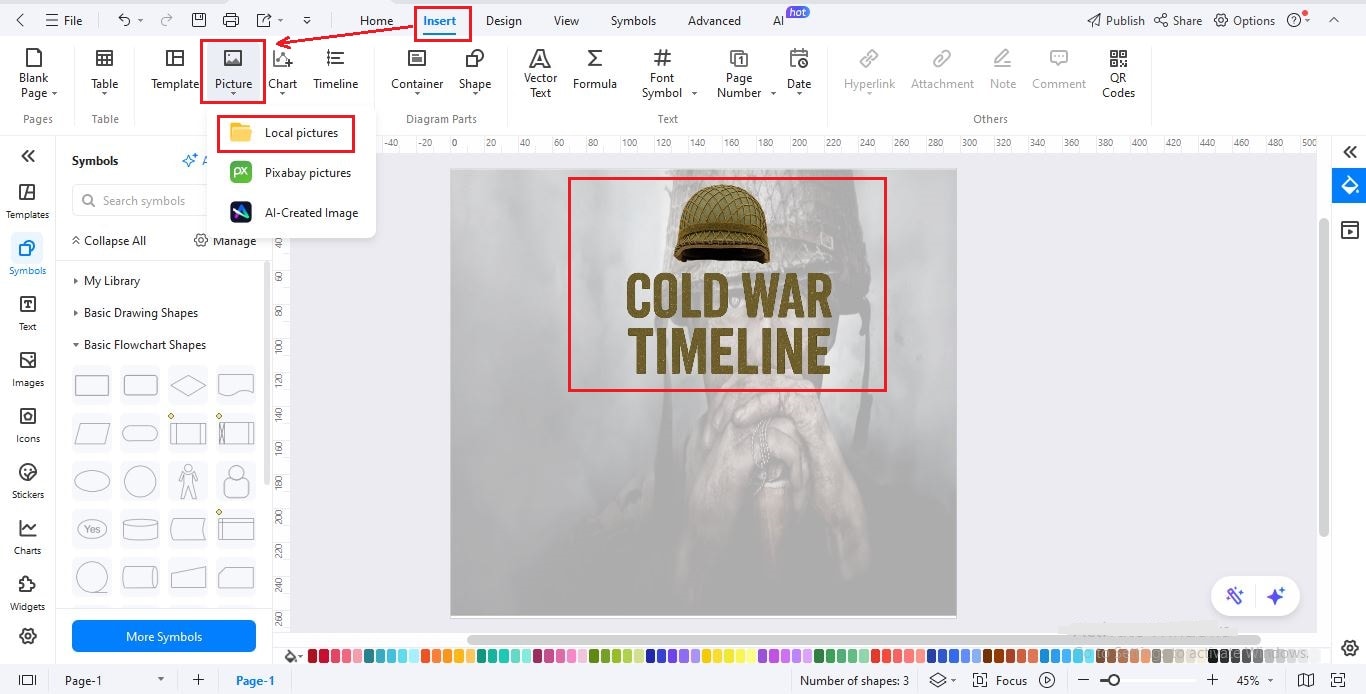
Step4Insert the Timeline Layout
- Click Insert in the top menu.
- Select Timeline and scroll through the options.
- Choose Horizontal Timeline and pick the option, which includes images.
- Click OK to add it to your canvas.
- Select the timeline to customize its structure from the toolbar.

Step5Add Text to the Timeline
- Start filling in important Cold War dates and events.
- On the left editing panel, click Text.
- Use Click to Add Subtitle for the year (e.g., 1947, 1961, 1989).
- Use Click to Add Body for a short description (e.g., Truman Doctrine, Berlin Wall built, Fall of Berlin Wall).
- Continue until you’ve included the key Cold War milestones.
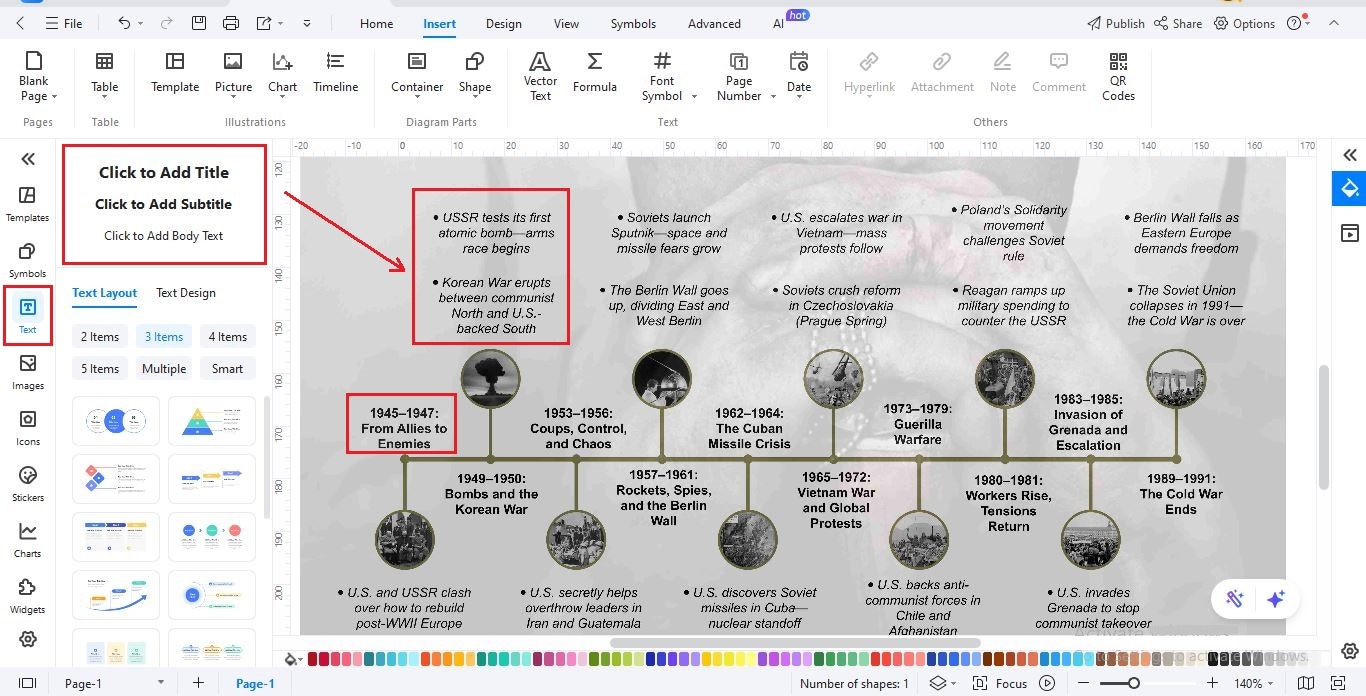
Step6Insert Thumbnail Images
- Make the timeline visually appealing with event-related thumbnails.
- Go to Insert > Picture > Local Pictures and upload images (e.g., portraits of leaders, maps, protests, missile sites).
- Use Crop to Shape to style them into circles or frames.
- Repeat the process for each milestone to make your timeline more engaging.
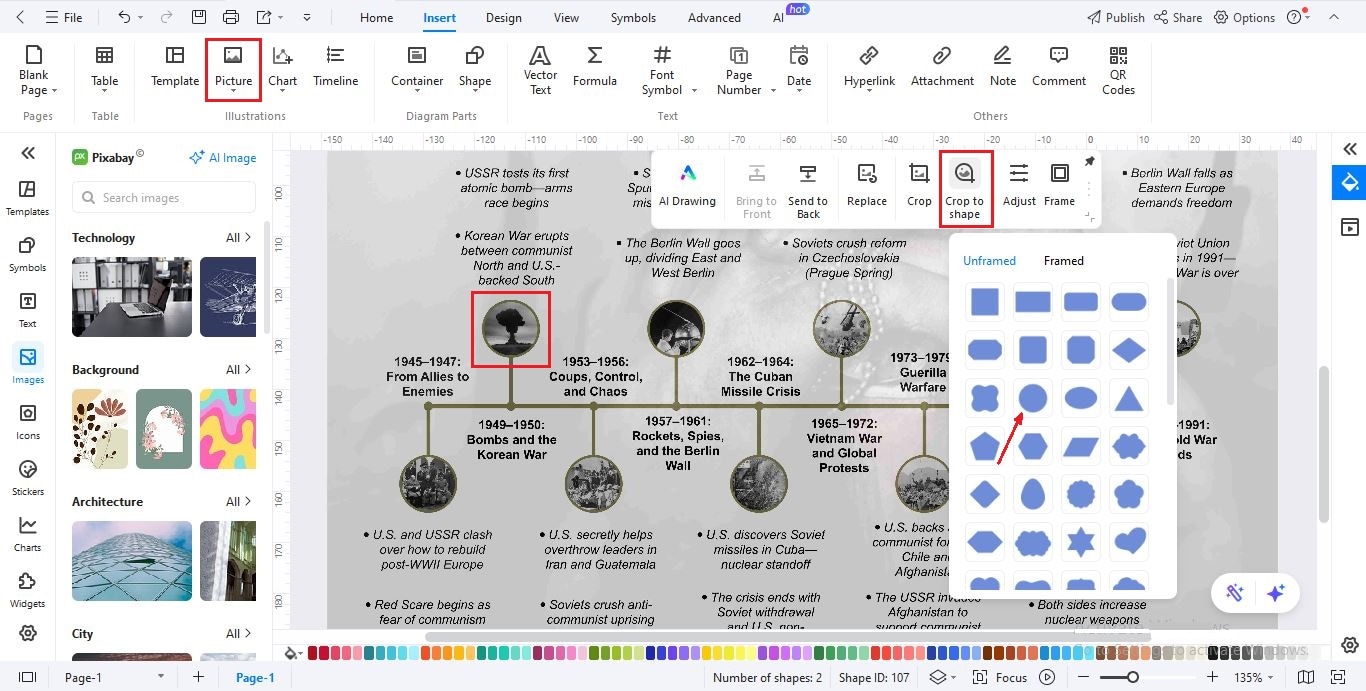
Step7Save, Share, or Export
- From the File menu, click Save to keep an editable version.
- Use the Share button (top-right) to collaborate or send your timeline to others.
- To export, go to File > Export and choose from PNG, PDF, SVG, HTML, Visio, or Excel.
- Click Publish to share your Cold War timeline with the EdrawMax community.

What’s Next?
The Cold War may be over, but its legacy is everywhere, from nuclear treaties to political alliances. It was a conflict fought with spies, speeches, and weapons that were too dangerous to use.
So, do you want to organize these events visually? Try EdrawMax. You can create timelines, charts, and mind maps that make history clear and engaging. It’s a powerful way to connect the dots and bring complex stories like the Cold War to life.




